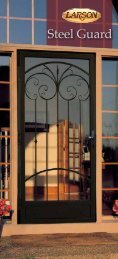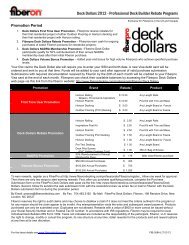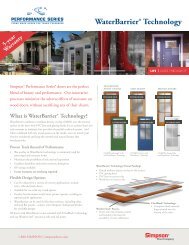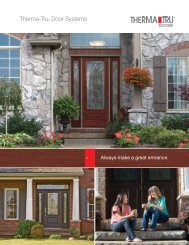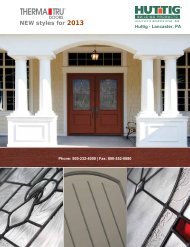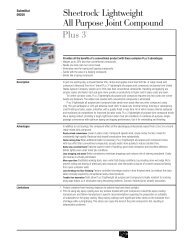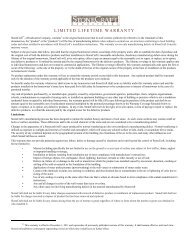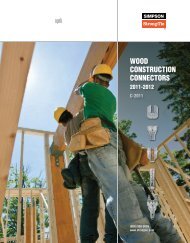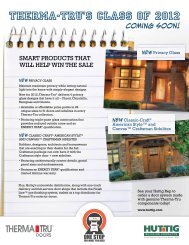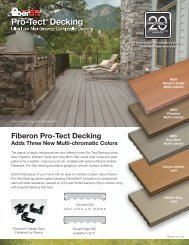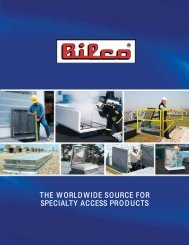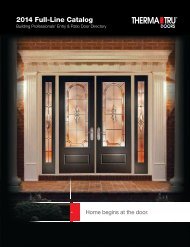ATLAS ROOFING PRODUCT GUIDE - Huttig Building Products
ATLAS ROOFING PRODUCT GUIDE - Huttig Building Products
ATLAS ROOFING PRODUCT GUIDE - Huttig Building Products
Create successful ePaper yourself
Turn your PDF publications into a flip-book with our unique Google optimized e-Paper software.
atlasroofing.com<br />
PoLyiso insuLation <strong>Products</strong><br />
When it comes to selecting the best overall insulation product for roof systems,<br />
Polyiso is the product of choice. No other foam plastic insulation has the perfect<br />
combination of features so important for long-term performance. These features<br />
provide excellent initial installation costs, as well as attractive life-cycle payback<br />
rates, which can be easily calculated by using the EnergyWise Roof Calculator Online<br />
(NRCA/PIMA). Ask your Atlas Sales representative for a demonstration.<br />
Introduction<br />
From our start as a single asphalt shingle manufacturing company in 1982,<br />
to becoming a recognized leader and driving force in the green movement<br />
today, Atlas has done more than simply adapt to industry trends; we’ve led<br />
the way in setting standards.<br />
Convinced that building “green” was not just a cliché or bandwagon to<br />
jump on, Atlas became a pioneer in the manufacturing of “Green Polyiso”<br />
insulation. Polyiso–a closed-cell, rigid foam board insulation–is used<br />
primarily on the roofs of commercial buildings where high thermal<br />
performance is essential. The term “Green Polyiso” refers to Environmentally-<br />
Friendly, polyisocyanurate insulation with Zero Ozone Depletion Potential<br />
(ODP), and Zero Global Warming Potential (GWP) .<br />
Through the development of our patented hydrocarbon blowing technology<br />
called ACUltra® Technology, Atlas became the first Polyiso manufacturer to cease<br />
the use of Chlorofluorocarbons (CFCs) in 1993 and Hydrofluorocarbons (HCFCs) in<br />
1998, years ahead of the Montreal Protocol deadline for compliance. Due to the<br />
material’s contribution to energy efficiency throughout a building’s life, LEED<br />
credits and life cycle assessment, Owners, Architects, Specifiers, and Contractors<br />
all recognize the vast benefits of choosing Polyiso as their insulation board.<br />
Polyiso insulation is the only foam plastic insulation that can be used in almost all types of<br />
roof systems without the need for a thermal barrier. Polyiso’s high-temperature stability<br />
prevents melting when mopped with hot bitumen. Polyiso is unaffected by properly applied<br />
construction adhesives, and many membrane manufacturers specify its use without the<br />
need for a cover board in single-ply adhered systems.<br />
Atlas recommends ACFoam® Roof Insulation only for roofing applications installed by a<br />
qualified contractor. FM Approvals has approved the use of ACFoam® as a component in<br />
Class 1 insulated roof deck construction. ACFoam® has also been tested and Classified by<br />
Underwriters Laboratories as a component of an insulated roof deck.<br />
Life-cycLe assessment<br />
Besides its many well-known benefits, including serving as<br />
an appropriate base for roof membranes, improving occupant<br />
comfort, reducing potential for condensation, and reducing<br />
operating expenses, ACFoam® also provides a positive Life-Cycle<br />
Assessment, a key measure of sustainability. Based on a cradleto-grave<br />
assessment, Polyiso greatly reduces fossil fuel use and<br />
associated carbon emissions. Energy savings and carbon reductions<br />
greatly outweigh the marginal embodied energy needed for the<br />
creation, use, and disposal of the material. For more information,<br />
visit www.GreenPolyiso.com and search Life-Cycle Assessment.<br />
ACFoam® Leed Credits<br />
materiaLs & resources<br />
• Construction Waste Management: Credit 2<br />
If the total percentage of reused materials in a project does not meet the<br />
minimum levels stated in the Materials and Resources, Credit 1, <strong>Building</strong><br />
Reuse, these reuse activities may be applied to this credit.<br />
• Materials Reuse: Credit 3<br />
Polyiso can be and often is reused in order to reduce demand for virgin<br />
materials and reduce waste.<br />
• Recycled Content: Credit 4<br />
ACFoam®-II roof insulation can be used toward one of the levels of<br />
recycled materials credit.<br />
• Local/Regional Materials: Credit 5<br />
Atlas has seven Polyiso insulation plants and sources of raw materials<br />
across North America. Therefore, the use of ACFoam® roof insulation may<br />
contribute towards gaining this credit, depending on the project location<br />
and the version of LEED being used as the basis of design.<br />
enerGy & atmosPhere<br />
• Minimum Energy Performance: Prerequisite 2<br />
Thermally efficient ACFoam® roof insulation facilitates compliance with<br />
ASHRAE 90.1-2007 and local energy codes.<br />
• Optimize Energy Performance: Credit 1<br />
ACFoam® roof insulation provides the highest thermal resistance per<br />
inch of material and can economically contribute to achieving the LEED<br />
mandatory and optional credits for optimized energy performance.<br />
recycLed content<br />
ACFoam®-II roof insulation contains between 16% and<br />
43% recycled materials by weight, depending on thickness.<br />
Since the facers are made of 100% recycled materials<br />
(57% post-consumer, 43% pre-consumer), the thinner the<br />
product, the higher the recycled content.<br />
A double layer application of insulation with staggered<br />
joints is well known for its improved thermal efficiency<br />
(prevention of heat loss or gain) over a single layer. Also<br />
important, a double layer can increase the level of recycled<br />
material in the total roof insulation.<br />
greenzone.com



